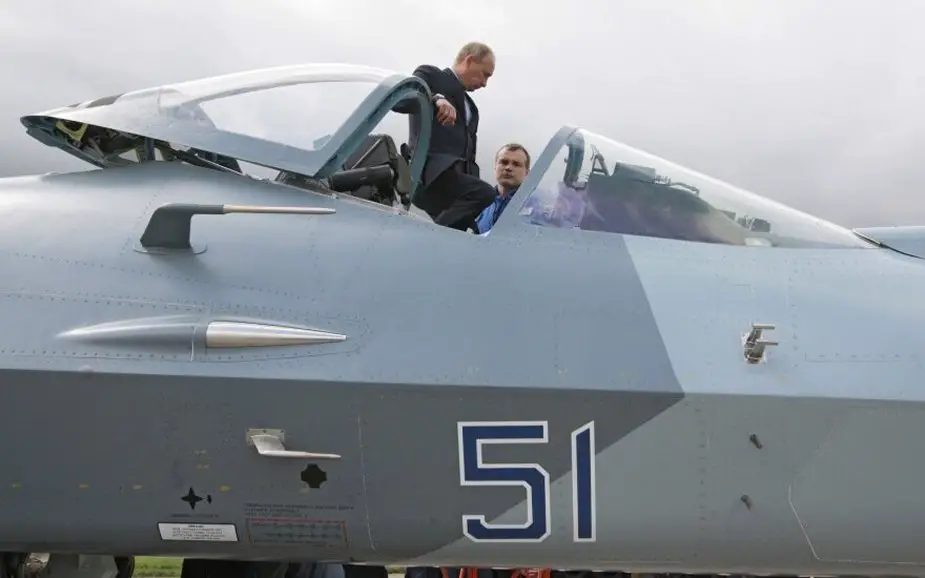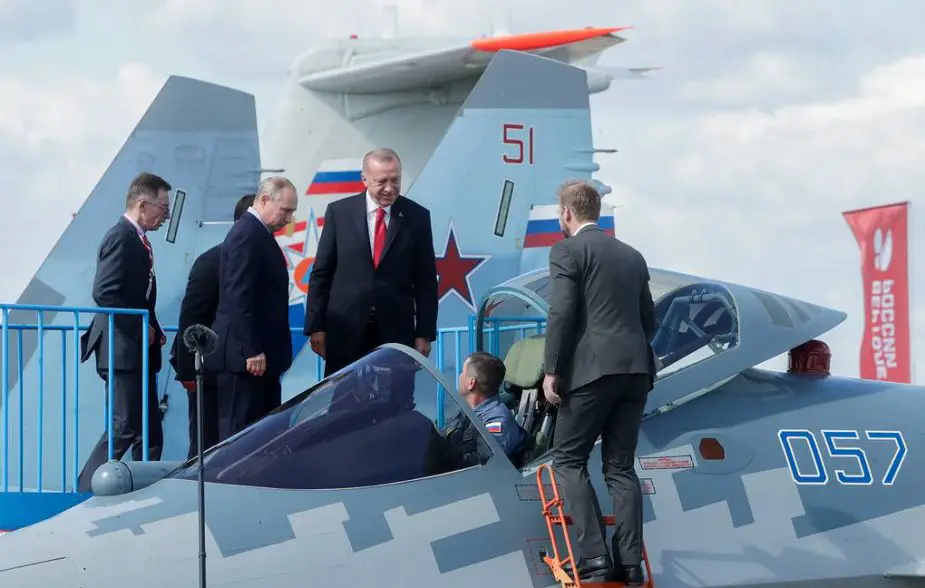Breaking news
Analysis: First use of Russian Su-57 fighter aircraft in Ukraine's war.
Experts from Military Watch magazine have analyzed the combat capabilities of Russia’s fifth-generation Sukhoi Su-57 (NATO reporting name: Felon) fighter jet and named five missions the aircraft is most likely to be fulfilling in the Ukrainian airspace.
Follow Air Recognition on Google News at this link
 Sukhoi Su-57 fighter aircraft (Picture source: delfi)
Sukhoi Su-57 fighter aircraft (Picture source: delfi)
A source in Russia’s defense industry told TASS on May 20 that Russia’s Aerospace Force was using Su-57 fighter jets in the special military operation in Ukraine. According to the source, they are delivering standoff missile attacks. As the source specified, the Aerospace Force started to use Su-57 aircraft two or three weeks after the special operation began.
Electronic attack
According to the experts of the magazine, the Su-57 is considered to have the most powerful electronic warfare capabilities among the fighters in service in Russia and could be deployed in an electronic attack role.
The Su-57 carries six electronically scanned array radars across the airframe operating in different bands, as well as a laser defense system intended to blind infrared-guided weapons. The fighter also integrates the Himalayas electronic warfare (EW) system, which is not stored in a single area on the fuselage but instead distributed across the airframe including in the wings to better interfere with enemy targeting systems.
Sensor and network-centric warfare testing
The Su-57 deploys twice or more as many radars as any other fighter in the world, which allows tracking up to 60 targets simultaneously.
The fighter’s ability to operate alongside other Russian assets, ranging from S-400 missile systems in Belarus that have contributed to the war effort to older Su-34 strike fighter units, could also be tested, the experts note. “This could be particularly valuable for advancing the capabilities of its data links and next-generation level network-centric warfare capabilities,” according to the article.
Export demonstrations
Like most post-Cold War tactical weapons systems the Su-57 program was largely developed with export in mind, the experts note. According to them, the fighter’s deployments to Syria and more recently to Ukraine were long speculated to be intended to increase foreign interest and demonstrate Russian confidence in the design.
Algeria has been widely reported to have already placed an order for Su-57 fighters. The list of potential customers also includes India, Vietnam, Myanmar, Kazakhstan and some other countries.
 Sukhoi Su-57 fighter aircraft (Picture source: Bmpd)
Sukhoi Su-57 fighter aircraft (Picture source: Bmpd)
Pilot experience under combat conditions
As the experts say, transitioning Russian pilots and maintenance crews to operating the Su-57 is expected to be a tenuous process due to the very significant discrepancy in technology level with prior fighter classes. However, Su-57 deployments to Ukraine could be seen as a way to provide a large pool of flight personnel with operational experience using the next-generation fighter. Also, this experience could be used to upgrade the plane, much as was the case when the Su-35 was tested in combat operations in Syria from early 2016.
Standoff weapons testing
According to the article, during the military operation, the Su-57 is likely to have made use of new standoff weapons such as the Kh-59MK2 cruise missile to neutralize Ukrainian targets from safe distances primarily for testing purposes but also to contribute to the war effort. The Kh-59MK2 cruise missile first tested in Syria provides a standoff strike capability, which very few aircraft in the world can match, the experts say.
Although the Su-57 carries some of the most capable air-to-air missiles of any fighter, these are less likely to be tested due to the paucity of manned aircraft still operating in Ukraine. “Nevertheless, even a kill against an unmanned aircraft would make the Su-57 the first fighter of its generation to gain a beyond visual range air to air victory,” the article notes.
Military Watch about Su-57
In February 2022, experts of Military Watch magazine said that the Su-57 was not expected to play any part in possible hostilities on Russia’s western borders. The first reason, according to them, is that their numbers in service are insufficient to form even a full-fledged squadron. Another factor is the lack of operational readiness. “Much like the American F-35 light stealth fighter, the Su-57 is not capable of high or medium intensity combat, and although technically operational is far from ready for a major war,” the article reads.
While the Su-57 appears to have less deficiencies than the F-35, and could be ready for high-intensity combat much sooner, it is expected to be some years perhaps until 2025 until it reaches such a stage, the experts believe. Before that time, the fighters in service will continue to be used to test new technologies and armaments and familiarize the Russian military with their next-generation systems.
According to the experts, the fighter’s capabilities are overwhelmingly superior to the Su-35, including a higher endurance, the ability to track 60 targets simultaneously using six radars on each fighter, integration of a nose-mounted AESA radar, stealth capabilities, and use of the new K-77M air-to-air missile as its primary armament, among many other advantages.
On February 26, the Military Watch experts supposed that the country’s Su-57 heavyweight fifth-generation fighters, which are deployed near Ukraine under the Southern Military District, could potentially be deployed for strike missions as part of the war effort.
Also, the use of the Su-57 could allow testing its advanced onboard systems in real combat. The talk is about the Su-57’s sensor suite, communications and new standoff weapons.
According to the experts, the Su-57’s stealth capabilities make it far more difficult to detect than any other Russian fighter. Its Himalayas EW system provides additional protection. Also, the Su-57 is equipped with a unique laser defense system able to blind handheld infrared guided surface-to-air missiles Ukrainian forces largely rely on.
The fighter also has a reduced heat signature compared to older Russian aircraft. It carries six radars — twice as many as the Su-35 and six times as many as other Russian and Western fighters.
According to the magazine, the Su-57’s ordnance would have potentially allowed Russian ground forces to progress significantly faster. The PBK-500U Drel glide bomb allows the fighter to engage targets 30-50 km away with high precision and a ‘fire and forget’ capability, using inertial and GLONASS satellite guidance.
A single submunitions cluster is reportedly sufficient to destroy an entire missile battery or a tank column, and its short range and lack of the need for thrusters or engines allows Su-57s to deploy considerably greater firepower when using it instead of standoff weapons. Each bomb contains fifteen self-guided anti-tank element charges, and their guidance and identification friend-or-foe systems make them optimal for engaging moving targets.
In addition to close air support, the Su-57 could also have neutralized Ukrainian air defenses far faster than existing fighters using the Kh-58UShE anti-radiation missile.
Su-57 fighter
The Su-57 is a fifth-generation multipurpose fighter jet designed to destroy all kinds of airborne, ground and naval targets. It features a supersonic cruising speed. It is equipped with armament inside its fuselage and an advanced avionics suite and has a radar-absorbing coating.
The Su-57 performed its maiden flight in 2010. The first fighter was delivered to the Russian armed forces in 2020. At the final meeting of the Defense Ministry’s board in December 2020, Russian Defense Minister Sergei Shoigu said that the Russian Aerospace Force was planned to receive 22 fighters by 2024. According to him, their number will be increased to 76 by 2028. The fighter’s first tests in real combat conditions took place in Syria in 2018.
 Sukhoi Su-57 fighter aircraft (Picture source: tass)
Sukhoi Su-57 fighter aircraft (Picture source: tass)
© Copyright 2022 TASS. All rights reserved. This material may not be published, broadcast, rewritten or redistributed.

























